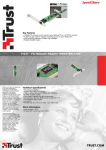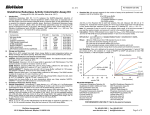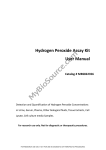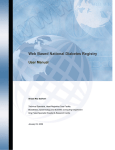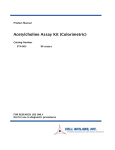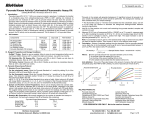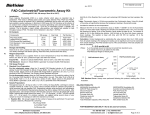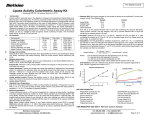Download Datasheet - BioVision
Transcript
BioVision (Catalog #K265-200; 200 reactions; Store kit at -20°C) Kit Contents: Components H2O2 Assay Buffer OxiRed™ Probe (in anhydrous DMSO) HRP H2O2 Standard (0.88 M) III. K265-200 Cap Code Part Number 25 ml 0.2 ml 1 vial 0.1 ml WM Red Green Yellow K265-200-1 K265-200-2A K265-200-4 K265-200-5 4. Measure OD (570 nm) or fluorescence (Ex/Em = 535/587 nm) in a micro-plate reader. 5. Calculation: Correct background by subtracting the value derived from the 0 nmol H2O2 control from all sample and standard readings (Note: The background reading can be significant and must be subtracted from sample readings). Plot the H2O2 standard curve. Apply your sample readings to the standard curve. H2O2 concentrations of the test samples can then be calculated, C=Sa/Sv (pmol/µl or µM), Where: Sa is the sample amount from your standard curve (in pmol), Sv is sample volume (µl). (a) (b) 1.5 Storage and Handling: Warm the assay buffer to room temperature before use. Briefly centrifuge vials prior to opening. Read the entire protocol before performing the assay. OxiRed™ Probe: Ready to use as supplied. Briefly warm at 37°C to melt frozen DMSO. The OxiRed™ Probe solution is stable for 1 week at 4°C and 1 month at -20°C. 0.5 HRP: Dissolve in 220 µl Assay Buffer, pipetting up and down. The HRP solution is stable for 1 week at 4°C and 1 month at -20°C. 0 BioVision Incorporated 155 S. Milpitas Boulevard, Milpitas, CA 95035 USA 2000 y = 0.121x + 0.0688 y = 5.3975x + 8.6908 0 0 2 4 6 8 10 12 0 200 400 600 800 1000 H2O2 (pmol) H2O2 (nmol) (c) 15 H2O2 (pmol) Hydrogen Peroxide Assay: 1. Sample Preparations: Collect cell culture supernatant, serum, plasma, urine and other biological fluids (contains 0.8 6 µM H2O2). Centrifuge for 15 minutes at 1000 x g within 30 minutes of collection. Remove particulate pellet. Samples, especially those such as culture medium, tissue lysate or plasma should be filtered through a 10 kDa MW spin filter (BioVision, Cat 1997-25) to remove all proteins then kept at -80°C for storage. It is recommended with all sample types to assay immediately or aliquot and store the samples at -80°C. Avoid repeated freeze-thaw cycles. Add 2 - 50 µl samples into each well, bring the volume to 50 µl with assay buffer. 2. H2O2 Standard Curve: For the Colorimetric Assay: Dilute 10 µl 0.88 M H2O2 standard into 870 µl dH2O to generate a 10 mM H2O2 standard, then dilute 10 µl of the 10 mM H2O2 standard into 990 µl dH2O to generate a 0.1 mM H2O2 standard. Add 0, 10, 20, 30, 40, 50 µl of the 0.1 mM H2O2 standard into 96-well plate in duplicate to generate 0, 1, 2, 3, 4, 5 nmol/well H2O2 standard. For the Fluorometric Assay: Dilute 100 µl of the 0.1 mM H2O2 standard into 900 µl dH2O to generate a 10 µM H2O2 Standard. Add 0, 10, 20, 30, 40, 50 µl of the 10 µM H2O2 standard into a 96-well plate in duplicate to generate 0, 0.1, 0.2, 0.3, 0.4, 0.5 nmol/well H2O2 standard. H2O2 Standard Curve: Fluorometric 4000 1 IV. Reagent Reconstitution and General Consideration: V. 6000 H2O2 Standard Curve: Colorimetric OD 570 II. Introduction: Hydrogen Peroxide is a reactive oxygen metabolic byproduct that serves as a key regulator for a number of oxidative stress-related states. Functioning through NF-B and other factors, hydroperoxide-mediated pathways have been linked to asthma, inflammatory arthritis, atherosclerosis, diabetic vasculopathy, osteoporosis, neuro-degenerative diseases, Down’s syndrome and immune system diseases. BioVision’s Hydrogen Peroxide Assay Kit is a highly sensitive, simple, direct and HTS-ready colorimetric and fluorometric assay for measuring H2O2 in biological samples. In the presence of Horse Radish Peroxidase (HRP), the OxiRed Probe reacts with H2O2 to produce product with color (λmax = 570 nm) and red-fluorescent (Ex/Em = 535/587 nm). The kit can perform 200 reactions by fluorometric method or 100 reactions by colorimetric method. The detection limit can be as low as 2 pmol/well (or 40 nM) of H2O2 in the sensitive fluorometric assay. 3. Reaction Mix: Mix enough reagents for the number of assays to be performed. For each well, prepare a total 50 µl Reaction Mix: Colorimetric Assay Fluorometric Assay 46 µl Assay Buffer 48 µl Assay Buffer 2 µl OxiRed™ Probe solution 1 µl OxiRed™ Probe solution 2 µl HRP solution 1 µl HRP solution Add 50 µl of the Reaction Mix to each test samples and H2O2 standards. Mix well. Incubate at room temperature for 10 min. *For a more sensitive assay, you can dilute the standard 10 fold further, decrease OxiRed™ amount to 0.2 µl and HRP amount to 0.4 µl per well, it will decrease the fluorescence background and detects as low as 2 pmol/well (or 40 µM) H2O2. RFU Hydrogen Peroxide Colorimetric/Fluorometric Assay Kit I. For research use only rev. 12/14 10 5 0 VI. J774 macrophage Figure: a) Colorimetric Standard Curve. b) Fluorometric Standard Curve and c) Quantification of H2O2 in murine macrophage J774 cells. ~3.8X106 cells were lysed in 380 μl of Assay buffer. Cell lysate was centrifuged at 10,000xg for 2 min. and collected supernatant was filtered through a 10 kDa MW spin filter (Cat. # 1997). 10 μl was used to measure H2O2. Assay was performed following the kit protocol. RELATED PRODUCTS: Glutathione Reductase Assay Kit Colorimetric Glutathione Detection Kit (GSH, GSSG and Total) GST Colorimetric Assay Kit Acid Phosphatase Assay Kit Phosphate Fluorescence Assay Kit NAD/NADH Quantification Kit Glutathione Peroxidase Assay Kit ApoGSH Glutathione Detection Kit Glutathione Kit GST Fluorometric Assay Kit Triglyceride Assay Kit ADP/ATP Ratio Assay Kit Phosphate Colorimetric Assay Kit NADP/NADPH Quantitation Kit FOR RESEARCH USE ONLY! Not to be used on humans. Tel: 408-493-1800 | Fax: 408-493-1801 www.biovision.com | [email protected] Page 1 of 2 BioVision For research use only rev. 12/14 GENERAL TROUBLESHOOTING GUIDE: Problems Cause Solution Assay not working • Use of ice-cold assay buffer • Assay buffer must be at room temperature • Omission of a step in the protocol • Refer and follow the data sheet precisely • Plate read at incorrect wavelength • Check the wavelength in the data sheet and the filter settings of the instrument • Use of a different 96-well plate • Fluorescence: Black plates ; Luminescence: White plates; Colorimeters: Clear plates • Use of an incompatible sample type • Refer data sheet for details about incompatible samples • Samples prepared in a different buffer • Use the assay buffer provided in the kit or refer data sheet for instructions • Samples were not deproteinized (if indicated in datasheet) • Use the 10 kDa spin cut-off filter or PCA precipitation as indicated • Cell/ tissue samples were not completely homogenized • Use Dounce homogenizer (increase the number of strokes); observe for lysis under microscope • Samples used after multiple free-thaw cycles • Aliquot and freeze samples if needed to use multiple times • Presence of interfering substance in the sample • Troubleshoot if needed, deproteinize samples • Use of old or inappropriately stored samples • Use fresh samples or store at correct temperatures till use • Improperly thawed components • Thaw all components completely and mix gently before use • Use of expired kit or improperly stored reagents • Always check the expiry date and store the components appropriately • Allowing the reagents to sit for extended times on ice • Always thaw and prepare fresh reaction mix before use • Incorrect incubation times or temperatures • Refer datasheet & verify correct incubation times and temperatures • Incorrect volumes used • Use calibrated pipettes and aliquot correctly • Use of partially thawed components • Thaw and resuspend all components before preparing the reaction mix • Pipetting errors in the standard • Avoid pipetting small volumes • Pipetting errors in the reaction mix • Prepare a master reaction mix whenever possible • Air bubbles formed in well • Pipette gently against the wall of the tubes • Standard stock is at an incorrect concentration • Always refer the dilutions in the data sheet • Calculation errors • Recheck calculations after referring the data sheet • Substituting reagents from older kits/ lots • Use fresh components from the same kit • Measured at incorrect wavelength • Check the equipment and the filter setting • Samples contain interfering substances • Troubleshoot if it interferes with the kit • Use of incompatible sample type • Refer data sheet to check if sample is compatible with the kit or optimization is needed • Sample readings above/below the linear range • Concentrate/ Dilute sample so as to be in the linear range Samples with erratic readings Lower/ Higher readings in Samples and Standards Readings do not follow a linear pattern for Standard curve Unanticipated results Note: The most probable list of causes is under each problem section. Causes/ Solutions may overlap with other problems. BioVision Incorporated 155 S. Milpitas Boulevard, Milpitas, CA 95035 USA Tel: 408-493-1800 | Fax: 408-493-1801 www.biovision.com | [email protected] Page 2 of 2


